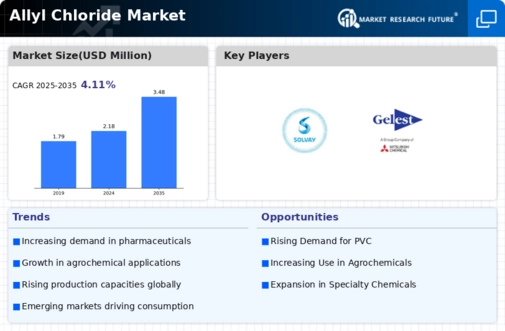Allyl Chloride Size
Allyl Chloride Market Growth Projections and Opportunities
The Allyl Chloride Market is influenced by a variety of factors that collectively shape its trends and growth patterns. One significant driver is the compound's extensive use in the production of various chemicals, including epichlorohydrin and allyl alcohol. These chemicals serve as crucial intermediates in the manufacturing of resins, plastics, and other specialty chemicals, contributing to the demand for allyl chloride across industries. As global manufacturing activities and chemical production continue to expand, the allyl chloride market experiences consistent growth.
Global economic conditions play a pivotal role in the Allyl Chloride Market. Economic growth and industrialization contribute to increased demand for chemicals and allied products, propelling the demand for allyl chloride. Developing economies, undergoing rapid industrial expansion, particularly drive the market's growth, emerging as significant consumers in the global chemical manufacturing landscape.
Technological advancements in chemical processes and manufacturing impact the market dynamics. Ongoing research and development efforts lead to innovations that enhance the efficiency, safety, and cost-effectiveness of allyl chloride production. Companies that invest in these technological advancements gain a competitive edge by offering high-quality allyl chloride that meets the evolving needs of various industries while optimizing production processes.
Environmental and regulatory considerations are pivotal factors in the Allyl Chloride Market. Allyl chloride is classified as a hazardous substance, and its production and use are subject to stringent environmental regulations. Companies in the market must comply with safety standards, invest in emission control technologies, and implement responsible manufacturing practices to ensure sustainable operations and regulatory compliance.
Geopolitical factors and trade dynamics also play a role in shaping the Allyl Chloride Market. Fluctuations in trade relations, changes in tariffs, and geopolitical tensions can impact the supply chain and pricing of allyl chloride. Companies in the market need to stay informed about global trade developments and adjust their strategies to navigate potential risks and capitalize on emerging opportunities in the global market.
Furthermore, the polymer industry significantly contributes to the demand for allyl chloride. Allyl chloride is utilized in the production of polymers and resins, including polypropylene, which finds applications in various end-use sectors such as packaging, automotive, and textiles. The growth of these industries, driven by consumer demand and technological advancements, fuels the demand for allyl chloride in polymer manufacturing.
The pharmaceutical sector is another key driver of the Allyl Chloride Market. Allyl chloride serves as a key intermediate in the synthesis of pharmaceuticals and agrochemicals. The pharmaceutical industry's continuous research and development efforts, coupled with the need for specialty chemicals in drug manufacturing, contribute to the demand for allyl chloride as a vital building block in these processes.
Raw material prices, particularly those of propylene and chlorine, play a role in shaping the Allyl Chloride Market. Fluctuations in the costs of these raw materials impact the production costs and pricing of allyl chloride. Companies in the market must implement effective supply chain strategies and cost management practices to navigate these raw material price dynamics.






Leave a Comment